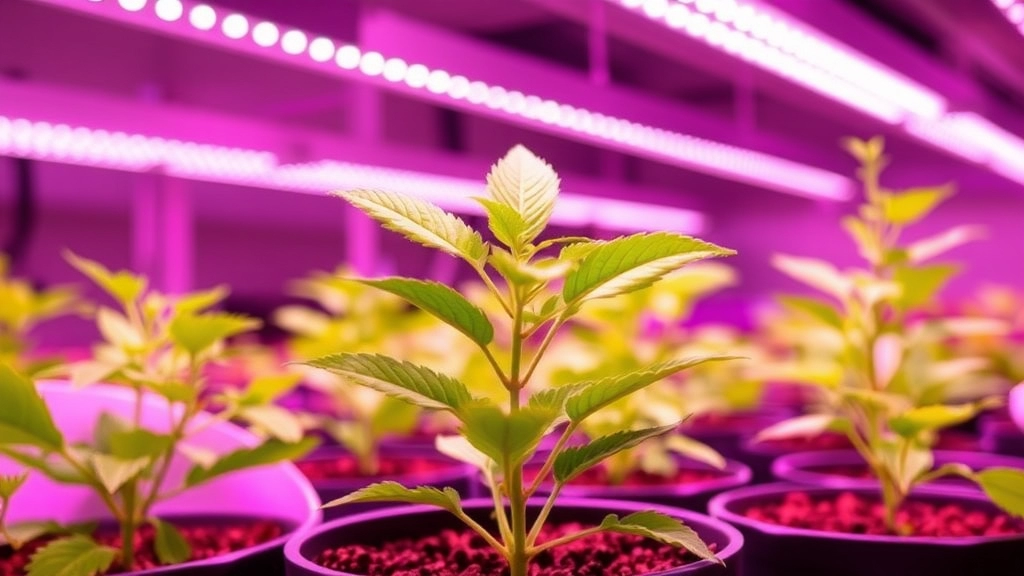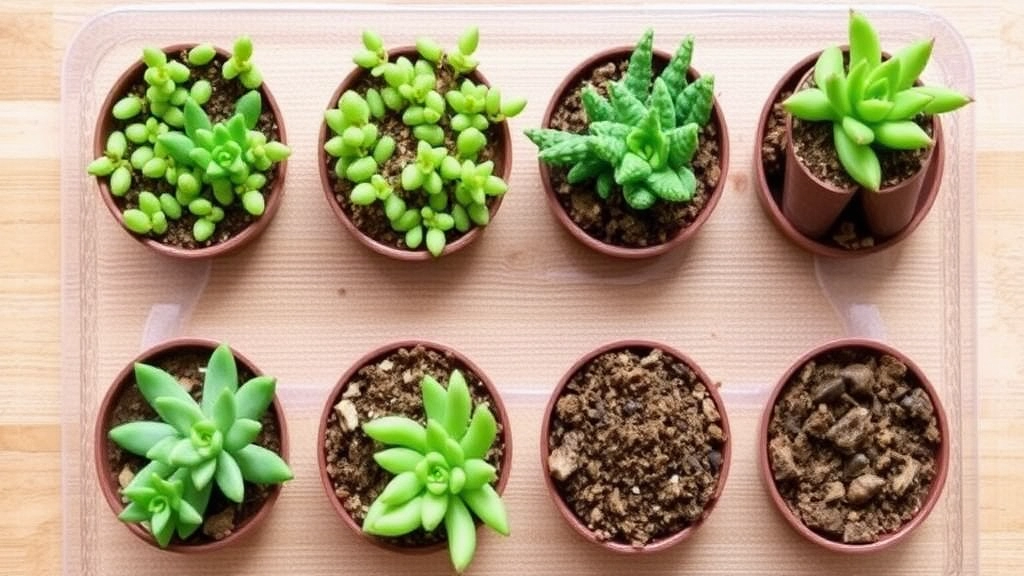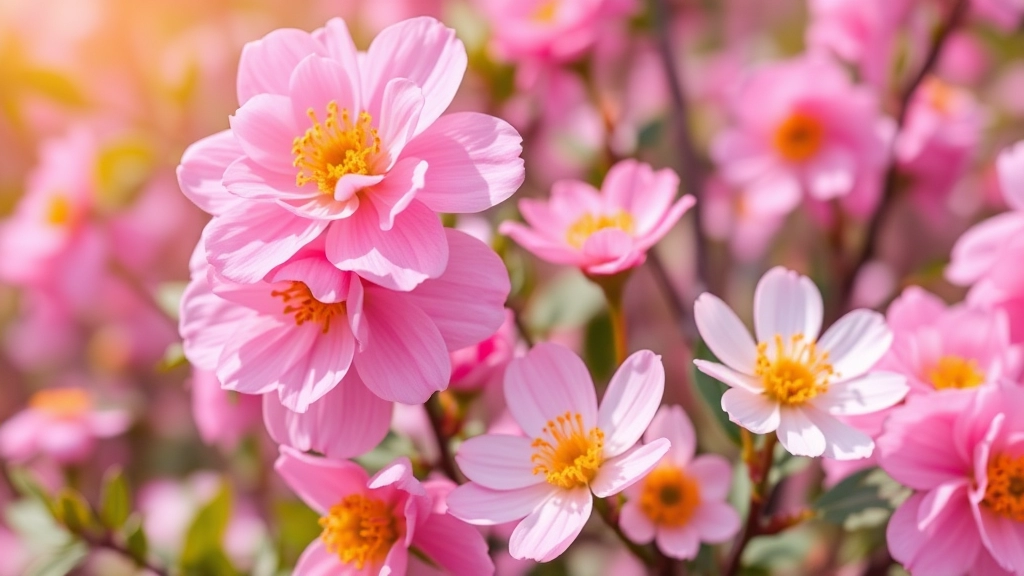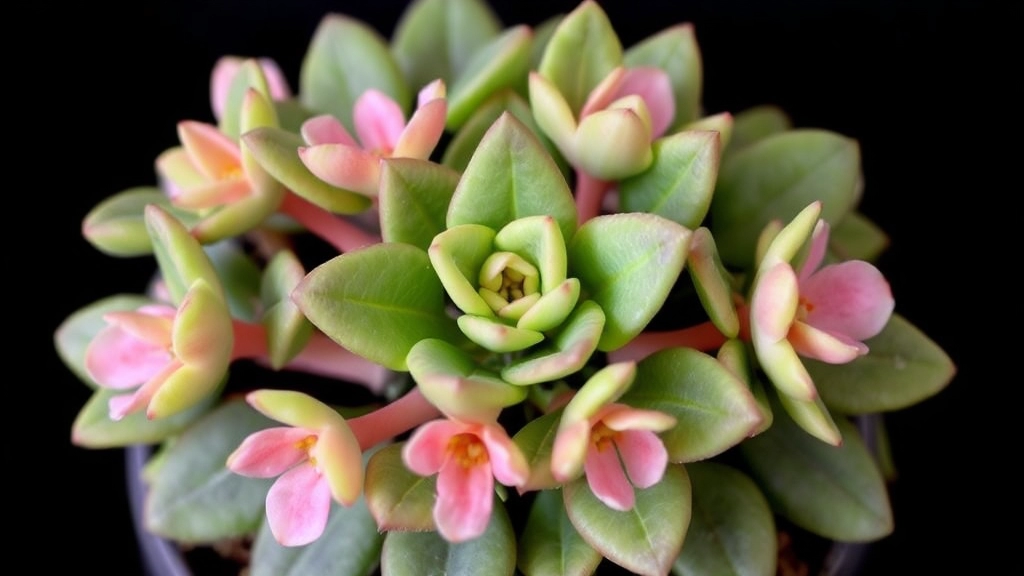Kalanchoe Laetivirens: The Mother of Thousands
When it comes to the Kalanchoe Laetivirens, often known as the Mother of Thousands, understanding its unique characteristics is key to successful care. This fascinating succulent is known for its ability to produce tiny plantlets along the edges of its leaves, making it a favourite among plant enthusiasts. Whether you’re a seasoned gardener or a newbie, learning about its care requirements, propagation techniques, and how it stacks up against similar species like the Mother of Millions can make all the difference.
Care Requirements
To keep your Kalanchoe Laetivirens thriving, you’ll need to focus on:
- Right lighting and temperature conditions
- Ideal watering practices
- Best soil types
This plant is resilient but can face issues like pests and diseases if not properly cared for. We’ll also dive into the blooming habits of this succulent and provide tips on how to encourage flowering, along with essential pruning and repotting advice for long-term health.
Conclusion
Stay tuned as we explore everything you need to know about this remarkable plant.
Key Characteristics of Kalanchoe Laetivirens
When considering houseplants that combine beauty with ease of care, Kalanchoe Laetivirens, commonly known as Mother of Thousands, often comes to mind. Many plant enthusiasts are drawn to its unique characteristics and resilience.
Distinctive Features
Kalanchoe Laetivirens is renowned for its striking appearance. Here are some key traits:
- Leaf Structure: The plant features thick, fleshy leaves that are typically green with a hint of blue-grey. These leaves can grow quite large, often reaching lengths of up to 15 cm.
- Reproductive Nature: This species is particularly fascinating due to its ability to produce tiny plantlets along the edges of its leaves. These plantlets can easily fall off and root themselves, leading to a proliferation of new plants.
- Growth Habit: It is a succulent, which means it stores water in its leaves. This characteristic allows it to thrive in dry conditions.
- Height and Spread: Kalanchoe Laetivirens can grow up to 60 cm tall, making it a striking addition to any indoor garden.
Understanding these characteristics is essential for successful cultivation. For more information on how to grow and care for this plant, check out our detailed guide on Kalanchoe Mother of Thousands. Additionally, if you’re interested in exploring other fascinating Kalanchoe varieties, our comprehensive guide on Kalanchoe species is a great resource.
Best Lighting and Temperature Conditions for Healthy Growth

So, you’ve got your Kalanchoe Laetivirens, and now you’re wondering about the best lighting and temperature conditions to keep it thriving, right?
Let’s dive in!
Lighting Needs
Kalanchoe Laetivirens loves bright, indirect sunlight.
- Direct Sunlight: Too much can scorch those lovely leaves.
- Shady Spots: Not ideal; your plant might become leggy and weak.
- Artificial Light: If natural light is scarce, grow lights can work wonders.
Temperature Preferences
When it comes to temperature, Kalanchoe is pretty chill.
- Ideal Range: Aim for 20-25°C (68-77°F) during the day.
- Nighttime Cool Down: A slight drop to around 15°C (59°F) is perfect.
- Avoid Frost: This plant is not a fan of cold weather, so keep it away from chilly drafts.
Seasonal Changes
As seasons change, so do the light and temperature needs.
- Summer: It can handle more light, so feel free to move it closer to a window.
- Winter: It might need a bit more warmth and light since days are shorter.
When it comes to caring for your Kalanchoe Laetivirens, understanding its watering and soil preferences is crucial. Many plant enthusiasts often wonder how to maintain the right balanceâtoo much water can lead to root rot, while too little can cause the plant to wilt.
### Watering Guidelines:
– **Frequency:** Water your Kalanchoe Laetivirens every 2-3 weeks. Adjust based on the season; reduce watering in winter.
– **Soil Moisture Check:** Before watering, always check the top inch of the soil. If it feels dry, it’s time to water.
– **Watering Technique:** When you do water, ensure you do so thoroughly. Allow water to flow through the drainage holes for effective hydration.
– **Signs of Overwatering:** Yellowing leaves and mushy stems are clear indicators that your plant is receiving too much water.
### Soil Requirements:
– **Soil Type:** A well-draining potting mix is essential. Look for a blend specifically designed for succulents or cacti.
– **pH Level:** Aim for a slightly acidic to neutral pH (around 6.0 to 7.0) to promote healthy growth.
– **Additives:** Consider adding perlite or coarse sand to improve drainage and aeration.
By adhering to these watering and soil requirements, you’ll set your Kalanchoe Laetivirens up for success. For more detailed care, you might find this [complete care guide for Kalanchoe Panda Plant](https://planthq.org/complete-care-guide-for-kalanchoe-panda-plant/) helpful. Additionally, understanding the [toxicity and safety tips for Kalanchoe Pink Butterflies](https://planthq.org/kalanchoe-pink-butterflies-toxicity-and-safety-tips/) can ensure that you keep your plant and household safe.
Propagation Techniques for Mother of Thousands

Many plant enthusiasts often wonder how to propagate their Kalanchoe laetivirens, commonly known as the Mother of Thousands. This succulent is not only beautiful but also remarkably easy to propagate, making it a favourite among gardeners.
Leaf and Offset Propagation
Offsets: One of the most effective methods for propagating Mother of Thousands is through offsets, or “pups,” that grow around the base of the plant. Here’s how to do it:
- Select Offsets: Look for healthy offsets that are at least a few inches tall.
- Remove Carefully: Gently twist or cut the offset away from the mother plant, ensuring you leave some roots intact.
- Let Them Callous: Allow the cut end to dry for a few days to form a callous, which helps prevent rot.
- Plant in Soil: Place the offset in well-draining soil and water lightly.
Leaves: You can also propagate using leaves, though this method may take longer.
- Choose Healthy Leaves: Select plump, healthy leaves from the mother plant.
- Remove and Callous: Just like with offsets, let the leaves callous for a few days.
- Lay on Soil: Place the leaves flat on the soil surface without burying them.
- Mist Occasionally: Lightly mist the leaves to maintain humidity, as roots will develop over time.
Timing and Conditions
When propagating, timing is crucial. Spring and summer are the best seasons for propagation, as the plant is actively growing.
- Temperature: Keep the environment warm, ideally between 20-25°C (68-77°F).
- Light: Provide bright, indirect light to encourage healthy growth.
By following these straightforward propagation techniques, you can easily expand your collection of Kalanchoe laetivirens.
Common Pests and Diseases: Prevention and Treatment
As we delve deeper into the care of Kalanchoe Laetivirens, it’s essential to address the common pests and diseases that can hinder its growth. Understanding these issues can help you maintain a healthy plant and enjoy its beauty for years to come.
Blooming Seasons and How to Encourage Flowering

Are you wondering when your Kalanchoe Laetivirens will bloom? You’re not alone. Many plant enthusiasts are eager to see those vibrant flowers pop up!
Blooming Seasons
Kalanchoe Laetivirens typically blooms in late winter to early spring. This is when the days start getting longer and the temperatures rise. You might see clusters of small, tubular flowers that can brighten up your space.
Encouraging Flowering
Now, let’s talk about how to coax those blooms out. Here are some straightforward tips to get your plant to flower:
- Light Exposure: Ensure your plant gets plenty of bright, indirect sunlight.
- Temperature Control: Keep it in a warm spot, ideally between 18-24°C (65-75°F).
- Watering Routine: Water less during the blooming phase. Let the soil dry out between waterings.
- Fertilisation: Use a balanced, water-soluble fertiliser every few weeks during the growing season.
- Pruning: After blooming, prune away dead flowers to encourage new growth.
These simple steps can make a world of difference in getting your Kalanchoe to show off its beautiful flowers!
VII. Pruning and Repotting Tips for Long-Term Care
As we explore the ongoing care of Kalanchoe laetivirens, pruning and repotting emerge as vital practices to ensure your plant thrives.
Why Pruning Matters
Pruning is essential for maintaining a healthy and attractive Kalanchoe laetivirens. It encourages new growth and helps manage its size.
- Timing: Prune in early spring before new growth begins.
- Tools: Use clean, sharp scissors or pruning shears to avoid damaging the plant.
- Technique: Remove dead or yellowing leaves and any leggy stems to promote bushier growth.
- Frequency: Aim to prune every few months to maintain shape and health.
Repotting Essentials
Repotting is crucial for providing fresh soil and more space for your Kalanchoe laetivirens to grow.
When to Repot:
- Signs: If roots are emerging from the drainage holes or the plant appears top-heavy, it’s time to repot.
- Frequency: Generally, repot every 1-2 years, depending on growth rate.
Repotting Steps:
- Choose the Right Pot: Select a pot that is one size larger with good drainage holes.
- Soil Selection: Use a well-draining cactus or succulent mix to prevent root rot. For more details on soil, check out the best soil for Kalanchoe Blossfeldiana care tips.
- Transplanting: Gently remove the plant from its current pot, shake off excess soil, and place it in the new pot. Fill with fresh soil and water lightly.
Maintaining Health Post-Pruning and Repotting
After pruning or repotting, your Kalanchoe laetivirens may need some extra care.
- Watering: Allow the soil to dry out slightly before watering again.
- Light: Ensure it receives adequate light but avoid direct sun for a few days post-pruning or repotting. If you’re looking for more expert advice, visit our expert tips on how to care for a Kalanchoe succulent.
- Observation: Keep an eye out for any signs of stress, like wilting or discoloration.
FAQs about Kalanchoe Laetivirens – Mother Of Thousands
What are the best lighting conditions for Kalanchoe Laetivirens?
Kalanchoe Laetivirens thrives in bright, indirect sunlight. Direct sunlight can scorch the leaves, while too much shade can make the plant leggy and weak. If natural light is insufficient, artificial grow lights can be a good alternative.
What temperature range is ideal for Kalanchoe Laetivirens?
The ideal temperature range for Kalanchoe Laetivirens is between 20-25°C (68-77°F) during the day and around 15°C (59°F) at night. The plant should be kept away from frosty conditions and cold drafts.
How do seasonal changes affect the care of Kalanchoe Laetivirens?
During summer, the plant can handle more light, so it can be moved closer to a window. In winter, it may need additional warmth and light due to shorter days.
What are the most effective propagation techniques for Mother of Thousands?
Offsets and leaves are the two primary methods for propagating Kalanchoe Laetivirens. Offsets, or “pups,” can be carefully removed and planted in well-draining soil after allowing them to callous. Leaves can also be used by letting them callous and then laying them flat on the soil surface.
When is the best time to propagate Kalanchoe Laetivirens?
Spring and summer are the best seasons for propagating Kalanchoe Laetivirens, as the plant is actively growing during these times. Ensure the environment is warm, ideally between 20-25°C (68-77°F), and provide bright, indirect light.
When does Kalanchoe Laetivirens typically bloom?
Kalanchoe Laetivirens usually blooms in late winter to early spring. This is when the days start getting longer and the temperatures begin to rise, leading to the appearance of clusters of small, tubular flowers.
How can I encourage my Kalanchoe Laetivirens to flower?
To encourage flowering, ensure the plant gets plenty of bright, indirect sunlight and is kept in a warm spot between 18-24°C (65-75°F). Water less during the blooming phase, allowing the soil to dry out between waterings. Use a balanced, water-soluble fertiliser every few weeks during the growing season and prune away dead flowers after blooming to encourage new growth.
References
-
Kalanchoe Plant Care â How To Grow A Kalanchoe
-
How to Grow and Care for Kalanchoe
-
Kalanchoe: How to Grow and Care for Kalanchoes
